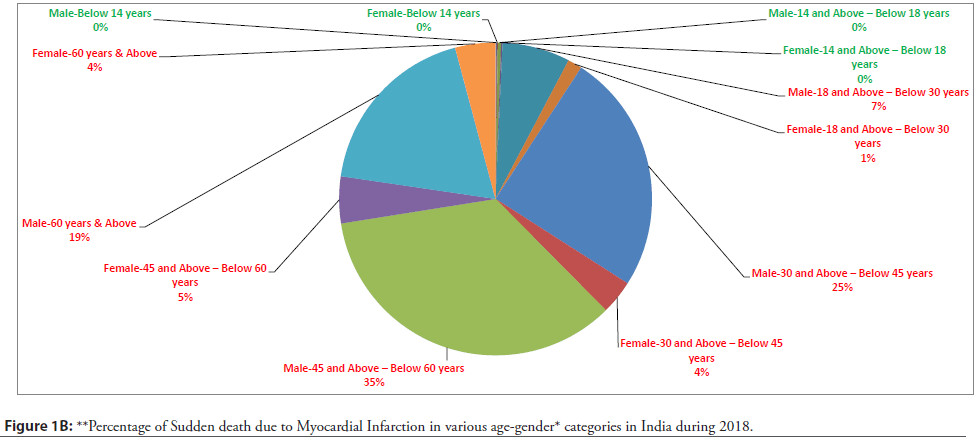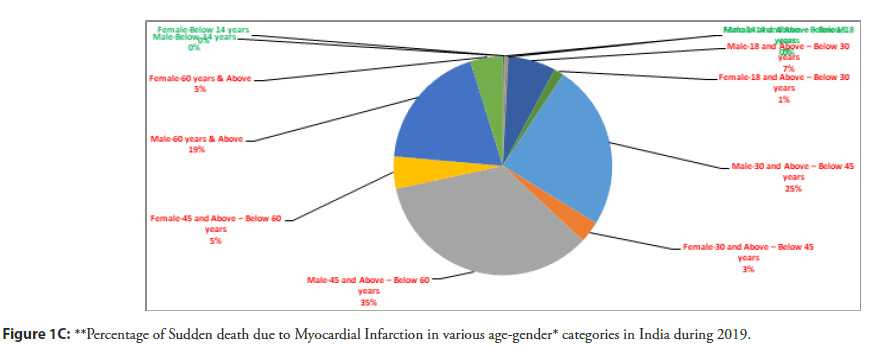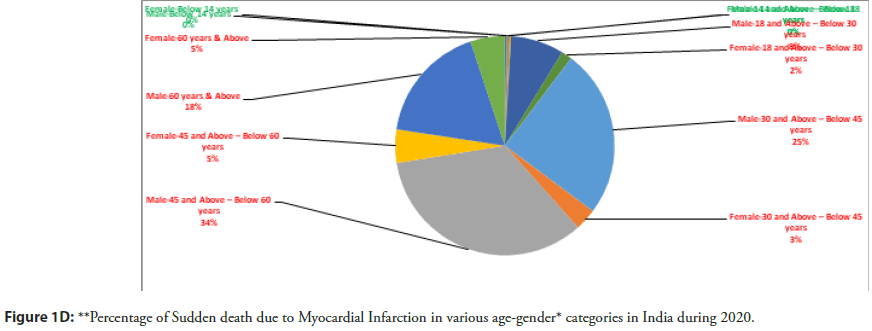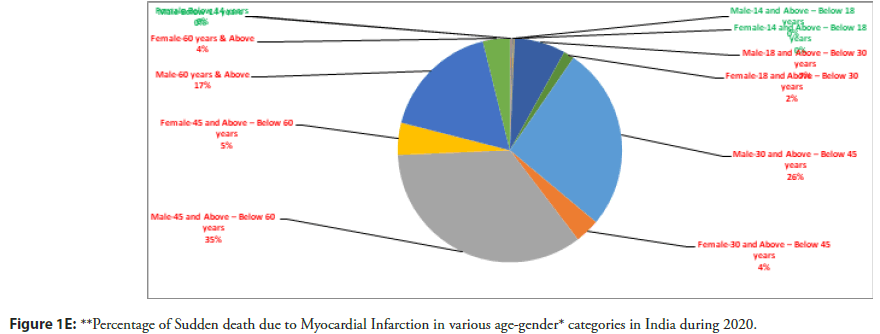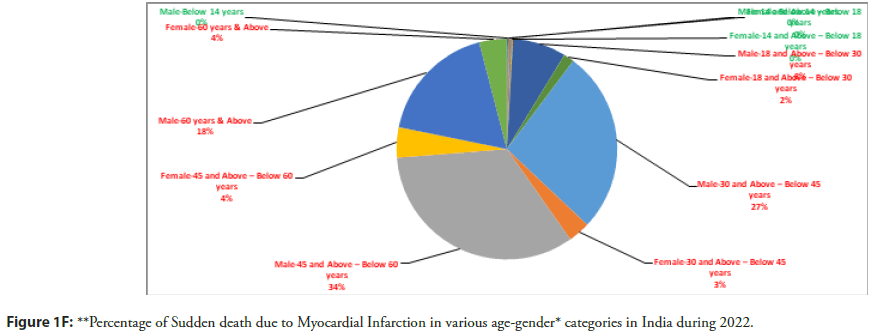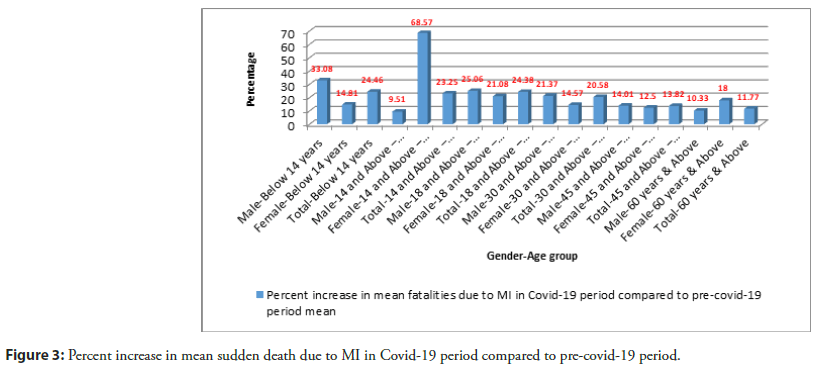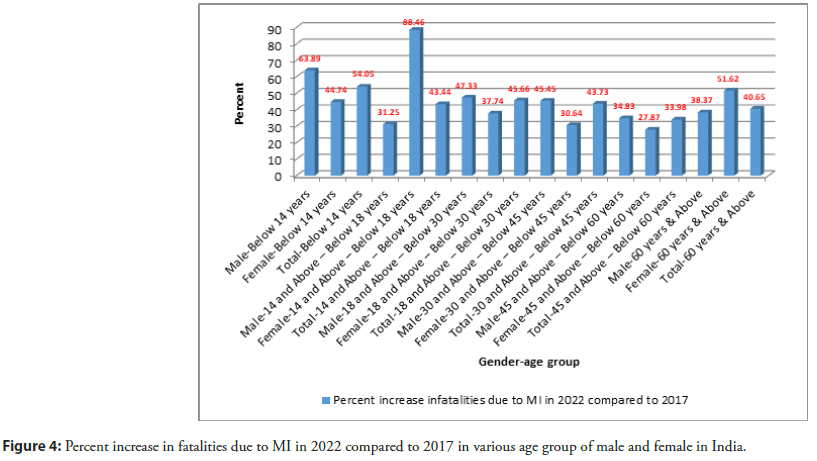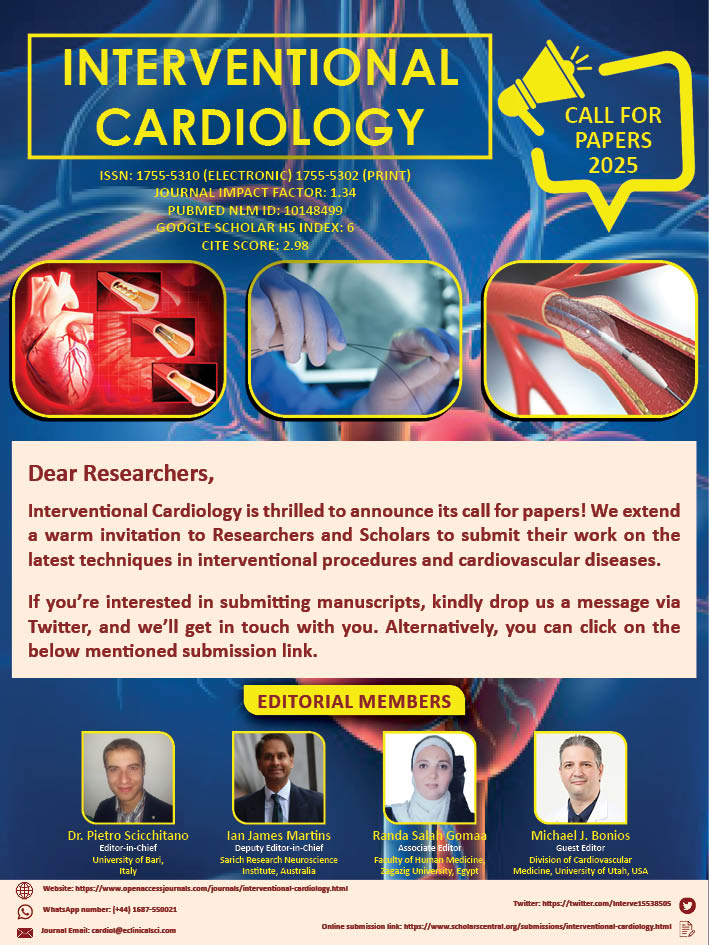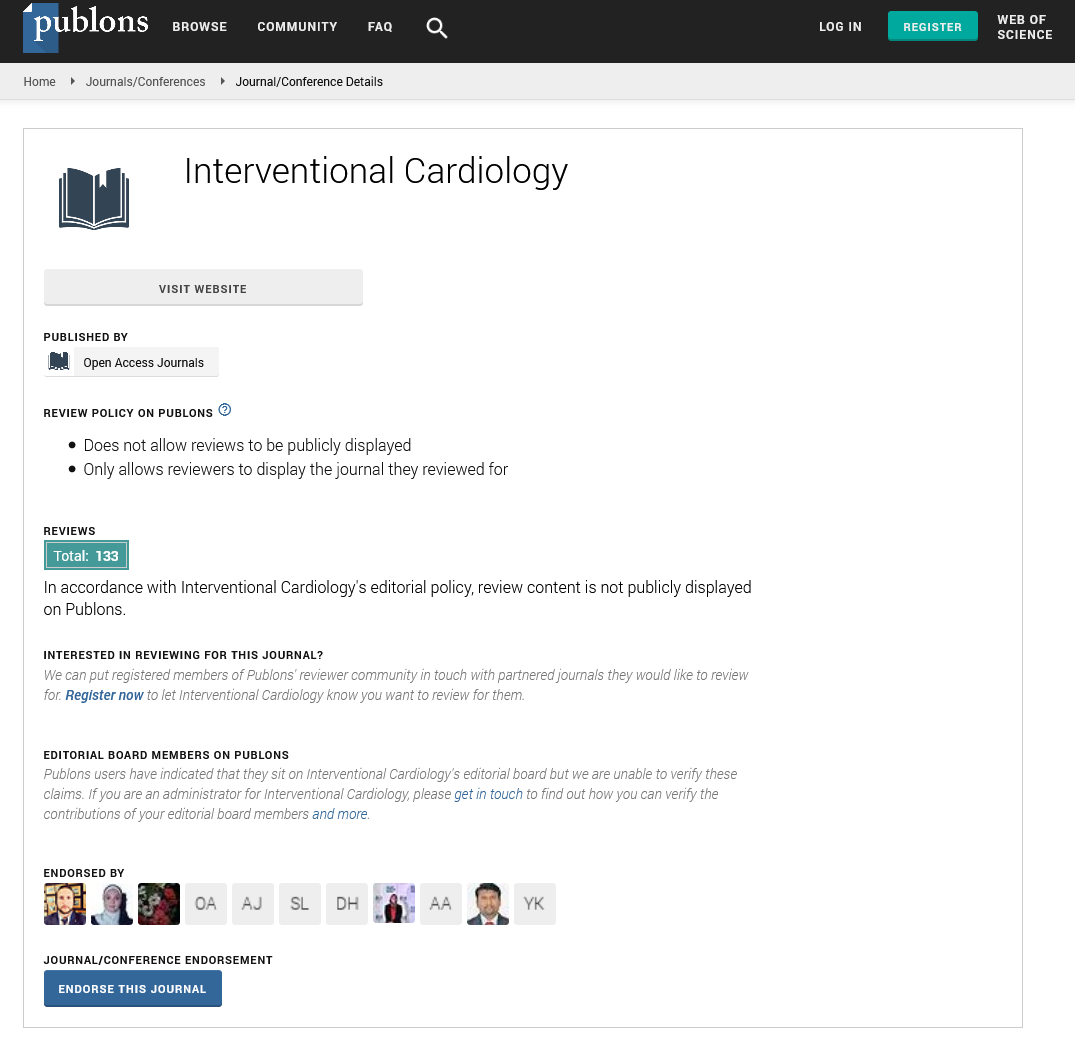Research Article - Interventional Cardiology (2024)
What impact does the COVID-19 pandemic era have on the incidence of myocardial infarction related fatalities in distinct age groups and gender? A comparison study (2017âÂÂ2022)
- Corresponding Author:
- Piyush Kumar
Department of Health, Sri Krishna Medical College and Hospital, Bihar, India
E-mail: drpiyush003@gmail.com
Received date: 01-Dec-2024, Manuscript No. FMIC-24-125009; Editor assigned: 03-Dec-2024, PreQC No. FMIC-23-125009 (PQ); Reviewed date: 17-Dec-2024, QC No. FMIC-24-125009; Revised date: 23-Dec-2024, Manuscript No. FMIC-24-125009 (R); Published date: 30-Dec-2024, DOI: 10.37532/1755- 5310.2024.16(S26).667
Abstract
Several studies, conducted earlier during the SARS, MERS, and recent COVID-19 pandemic, have indicated that coronavirus infection, particularly COVID-19 can lead to cardiac damage. There have been recorded cases of myocarditis or cardiomyopathy linked to COVID-19 vaccines, specifically those that use mRNA technology such as BNT162b2 and mRNA-1273, primarily affecting males between the ages of 16 and 30. The prevalence and characteristics of sudden death due to myocardial infarction in various age groups of both males and females during the COVID-19 period have not been extensively examined as compared to the time before COVID-19. The aim of this study is to analyze and contrast the disparities in the average and proportion of abrupt fatalities associated with heart attacks (MI) in different age groups of males and females in the COVID-19 era and the time prior to the global outbreak. This study revealed that the maximum number of sudden deaths due to MI occurs at age 45 and above but below 60 years. The percent increase in mean sudden death due to MI in the Covid-19 period compared to the pre- COVID-19 period mean was highest in females (68.57%) of age groups 14 and above but below 18 years, while it was lowest in the males (9.51%) of the same age group. The lowest mean mortality, 38.5 (95% Conf. Interval-Mean-23.81 -53.19) due to MI during the study period was found in females in age groups 14 and above but below 18 years. The highest mean mortality was 9540.5 (95% Conf. Interval-Mean: 8551.93- 10529.07) due to MI during the study period observed in Male aged 45 and above but below 60 years. The overall percent increase in fatalities due to MI in 2022 compared to 2017 is greatest (88.46%) in females between 14 and 17 years, while the lowest is in females between 45 and 59 years (27.87%). In all age groups an increase in fatalities due to MI is seen in 2022 compared to 2017.
Keywords
COVID-19 . Myocardial infarction . Heart attack . Incidence . Gender
Introduction
The outbreak of the novel coronavirus disease, which began in December 2019, is the result of humans contracting the SARS-CoV-2 virus infection [1]. COVID-19 is not considered a global public health emergency of international concern anymore (PHEIC) after May 5, 2023 [2]. The emergence of Severe Acute Respiratory Syndrome (SARS) in 2002 brought to light a previously unknown type of CoV (SARS-CoV), which is mainly accountable for respiratory illnesses in human beings [3]. COVID-19 has been found to impact various organs, which raises the chances of developing cardiovascular issues both in the short and long run [4-6]. These issues include blood clot formation in veins, abnormal heart rhythms, Myocardial Infarction (MI), Strokes (CVA-cerebrovascular accident), and bleeding, among other complications [7,8]. Progress in combating cardiovascular disease at a global level is not satisfactory [9,10]. Cardiovascular Diseases (CVD) are still one of the leading causes of death and disability in India [11]. In 2019, approximately 32% of global fatalities were due to CVDs [12]. Among these CVDrelated deaths, around 85% were specifically attributed to heart attacks and strokes [13]. A research finding (several such studies are available today) indicates that people who get infected with SARSCoV- 2 have an increased probability of succumbing to (CVDs [14-16]. Several studies, conducted earlier during the SARS, MERS, and recent COVID-19 pandemic, have indicated that different mechanisms can lead to cardiac damage, mainly through the activation of the Angiotensin-Converting Enzyme 2 receptor (ACE-2) [17-21]. There have been recorded cases of myocarditis/ cardiomyopathy linked to COVID-19 vaccines (10 out of every 100,000 individuals), specifically those that use mRNA technology such as BNT162b2 and mRNA-1273, primarily affecting males between the ages of 16 and 30 [22-26].
COVID-19 infections are expected to have a negative impact on the health outcomes and quality of life of individuals with cardiac conditions, as they increase the likelihood of complications, illness, and death. The prevalence and characteristics of sudden death due to myocardial infarction in various age groups of both males and females during the COVID-19 period have not been extensively examined and compared to the time before COVID-19. Additionally, research studies have not provided comprehensive information on this topic. However, it is important to acknowledge the long-term issues that can occur in various age groups of both males and females as a result of myocarditis or cardiomyopathy caused by COVID-19 or vaccination, which might require medical intervention. In order to protect the most susceptible age group, which includes both genders, from COVID- 19-related illnesses and disabilities, it is imperative to swiftly create a treatment strategy. By informing policymakers and decisionmakers on the necessity of developing cardiovascular care policies following the COVID-19 pandemic, in light of the findings of this research, we will try to close the knowledge gap.
Objective
As mentioned earlier, the COVID-19 pandemic exacerbated the incidence of cardiovascular illnesses. There are currently no research publications available comparing MI-related sudden deaths in different age groups of males and females before and during the COVID-19 pandemic on a country basis. Thus, our goal was to assess and compare the incidence of sudden cardiac death (MI) in different age groups of males and females in India (which includes all states and union territories of India) prior to and during the COVID-19 pandemic. The aim of this study is to analyse and contrast the disparities in the average and proportion of abrupt fatalities associated with heart attacks (MI) in different age groups of males and females in the COVID-19 era and the time prior to the global outbreak.
Materials and Methods
The aim of this study was to assess the impact of the COVID-19 pandemic on the number of MI-related sudden fatalities in India across various age categories of both males and females. The design of this study is retrospective, quantitative, and cross-sectional. We included all of India's states and Union Territories (UTs). January 2020 saw the first published report of a COVID-19 infection in India [27]. Hence, this study mentioned the time preceding January 1, 2020, as the period preceding the outbreak of COVID-19, and from January 1, 2020, until May 5, 2023, as the period characterized by the COVID-19 pandemic, according to the previously mentioned announcement made by the World Health Organization. It is important to evaluate the long-term impacts of the COVID-19 pandemic, despite a decrease in new COVID-19 cases beginning in 2022 [28]. We collected the data for our study from the reputable and official National Crime Records Bureau (NCRB) platform of the Indian government. This new study collected data on the annual number of deaths caused by heart attacks (myocardial infarction) in different age groups of males and females across the various states and Union Territories in India between January 1, 2017, and December 31, 2022.
Data sources
The data source is publicly available at the link given below:
The data is collected, cleaned, and analyzed by utilizing Microsoft Office and Stata software from the huge NCRB dataset. We have separated the data needed for this study with important calculations, which are presented in Table 1.
Results
Sudden deaths due to myocardial infarction in various agegender categories in India during 2017
In the study's base year of 2017 (prior to the COVID-19 pandemic), in various age categories, there were a total of 23,246 cases of myocardial infarction (MI) in males and females, resulting in sudden death, as shown in Table 1. Among these cases, 20027 (86.15%) were male, and the rest, 3219, were females (13.85%) of different age groups. We have done research on the impact of the COVID-19 pandemic on the incidence of sudden death due to MI in males and females across different states and UTs of India [29-31]. Hence, readers can view it for further details. Among the 23246 cases mentioned above, 35% were males of age 45 years above but below 60 years, 26% were males of age 30 years and above but below 45 years, 18% were males of age 60 years and above, 7% were males of age 18 years, and above but below 30 years. Among males of age 14 years and above but below 18 years and in males below 14 years, the sudden deaths due to MI were negligible (0%) compared to other groups, as shown in Table 1 and Figure 1-A. Among the 23246 cases mentioned above, 5% were females of age 45 years and above but below 60 years, 4% were females of age 60 years and above, 3% were females of age 30 years and above but below 45 years, and 2% were females of age 18 years and above but below 30 years. Among females of age 14 years and above but below 18 years, and in females below 14 years, the sudden deaths due to MI were negligible (0%) compared to other groups, as shown in Table 1 and Figure 1A. Overall, the percentage of sudden deaths due to myocardial infarction was highest in the age group 45 years and older but below 60 years of both genders in 2017 and lowest in females in the age group 14 and above but below 18 years, while in males it was lowest in the age group below 14 years.
Figure 1A: **Percentage of sudden death due to Myocardial Infarction in various age-gender* categories in India during 2017.
| Variable | Male-Below 14 years | Female-Below 14 years | Trans- gender-Below 14 years | Total-Below 14 years | Male-14 and Above – Below 18 years | Female-14 and Above – Below 18 years | Trans- gender-14 and Above – Below 18 years | Total-14 and Above – Below 18 years | Male-18 and Above – Below 30 years | Female-18 and Above – Below 30 years | Trans- gender-18 and Above – Below 30 years | Total-18 and Above – Below 30 years | Male-30 and Above – Below 45 years | Female-30 and Above – Below 45 years | Trans- gender-30 and Above – Below 45 years | Total-30 and Above – Below 45 years | Male-45 and Above – Below 60 years | Female-45 and Above – Below 60 years | Trans- gender-45 and Above – Below 60 years | Total-45 and Above – Below 60 years | Male-60 years & Above | Female-60 years & Above | Trans- gender-60 years & Above | Total-60 years & Above |
|---|---|---|---|---|---|---|---|---|---|---|---|---|---|---|---|---|---|---|---|---|---|---|---|---|
| Myocardial Infarction (Heart Attack)-2017 | 36 | 38 | 0 | 74 | 96 | 26 | 0 | 122 | 1724 | 363 | 0 | 2087 | 5961 | 803 | 0 | 6764 | 8050 | 1123 | 0 | 9173 | 4160 | 866 | 0 | 5026 |
| Myocardial Infarction (Heart Attack)-2018 | 34 | 26 | 0 | 60 | 90 | 35 | 0 | 125 | 1807 | 379 | 0 | 2186 | 6407 | 905 | 0 | 7312 | 8992 | 1246 | 0 | 10238 | 4771 | 1072 | 0 | 5843 |
| Myocardial Infarction (Heart Attack)-2019 | 51 | 44 | 0 | 95 | 98 | 25 | 0 | 123 | 1980 | 401 | 0 | 2381 | 6858 | 893 | 1 | 7752 | 9706 | 1334 | 2 | 11042 | 5267 | 1345 | 0 | 6612 |
| Mean -Pre-COVID-19 | 40.33 | 36 | 0 | 76.33 | 94.67 | 28.67 | 0 | 123.33 | 1837 | 381 | 0 | 2218 | 6408.67 | 867 | 0.33* | 7276 | 8916 | 1234.33 | 0.67 | 10151 | 4732.67 | 1094.33 | 0* | 5827 |
| Myocardial Infarction (Heart Attack)-2020 | 67 | 39 | 0 | 106 | 96 | 61 | 0 | 157 | 2249 | 446 | 0 | 2695 | 7131 | 922 | 2 | 8055 | 9771 | 1412 | 0 | 11183 | 5029 | 1455 | 0 | 6484 |
| Myocardial Infarction (Heart Attack)-2021 | 35 | 30 | 0 | 65 | 89 | 35 | 0 | 124 | 2103 | 438 | 0 | 2541 | 7534 | 1009 | 1 | 8544 | 9870 | 1318 | 2 | 11190 | 4879 | 1106 | 0 | 5985 |
| Myocardial Infarction (Heart Attack)-2022 | 59 | 55 | 0 | 114 | 126 | 49 | 0 | 175 | 2540 | 500 | 0 | 3040 | 8670 | 1049 | 3 | 9722 | 10854 | 1436 | 0 | 12290 | 5756 | 1313 | 0 | 7069 |
| Mean-COVID-19 | 53.67 | 41.33 | 0 | 95 | 103.67 | 48.33 | 0 | 152 | 2297.33 | 461.33 | 0 | 2758.67 | 7778.33 | 993.33 | 2 | 8773.67 | 10165 | 1388.67 | 0.67 | 11554.33 | 5221.33 | 1291.33 | 0 | 6512.67 |
| Percent increase in mean during Covid-19 | 33.08 | 14.81 | NA* | 24.46 | 9.51 | 68.57 | NA* | 23.25 | 25.06 | 21.08 | NA* | 24.38 | 21.37 | 14.57 | NA* | 20.58 | 14.01 | 12.5 | NA* | 13.82 | 10.33 | 18 | NA* | 11.77 |
Note: * There is insufficient data on transgender individuals, NA- Not Applicable
Table 1: Sudden deaths due to myocardial infarction in various age-gender categories in India during 2022, 2021, 2020, 2019, 2018, and 2017.
Sudden death due to Myocardial Infarction in various agegender categories in India during 2018
Table 1 shows that in 2018, before the COVID-19 pandemic, there were 25,764 cases of MI in males and females across various age groups, which resulted in sudden death. This is an increase of 10.83% over 2017. Of these instances, there were 22101 males (85.78%) and 3663 females (14.22%) of various ages.
Of the 25764 cases described above, 35% of the males were 45 years of age or older but under 60 years, 25% were males 30 years of age or older but under 45 years, 19% were 60 years of age or older, and 7% were males 18 years of age or older but under 30 years. As demonstrated in Table 1 and Figure 1-B, the percentage of boys under the age of 14 and those over 14 but below 18 who died suddenly from MI was very small (0%) in comparison to the other groups.
Figure 1B: **Percentage of Sudden death due to Myocardial Infarction in various age-gender* categories in India during 2018.
Of the 25764 cases listed above, 5% were females 45 years of age or older but under 60 years of age, 4% were females 60 years of age or older, 4% were females 30 years of age or older but under 45 years of age, and 1% were girls 18 years of age or older but under 30 years of age. As indicated by Table 1 and Figure 1B, the percentage of sudden MI-related deaths in girls aged 14 and older but under 18 years and in females less than 14 years was insignificant (0%) in comparison to other groups.
In 2018, the age group 45 years and above but below 60 years had the highest proportion of sudden cardiac death due to myocardial infarction, for both genders. The age group below 14 years for females and males had the lowest percentage of sudden cardiac death due to myocardial infarction.
Sudden death due to Myocardial Infarction in various agegender categories in India during 2019
According to Table 1, there were 28,002 cases of MI in males and females across all age categories in 2019 prior to the COVID-19 pandemic, which resulted in sudden mortality. Compared to 2018, this is an 8.69% rise. There were 4042 female (14.43%) and 23960 male (85.57%) of different ages among these cases.
Of the 28,002 cases described above, 35% of the males were 45 years of age or older but under 60 years, 25% were males 30 years of age or older but under 45 years, 19% were 60 years of age or older, and 7% were males 18 years of age or older but under 30 years. As demonstrated in Table 1 and Figure 1C, the percentage of boys under the age of 14 and those over 14 but below 18 who died suddenly from MI was very small (0%) in comparison to the other groups.
Figure 1C: **Percentage of Sudden death due to Myocardial Infarction in various age-gender* categories in India during 2019.
Out of the total number of 28,002 cases mentioned earlier, 5% were women who were between the ages of 45 and 59, 5% were women who were 60 years old or above, 3% were women who were between the ages of 30 and 44, and 1% were girls who were between the ages of 18 and 29. According to the data shown in Table 1 and Figure 1-C, the percentage of sudden MI-related deaths among girls aged 14-17 and females under 14 years old was negligible (0%) compared to other demographics.
In the year 2019, individuals who were between the ages of 45 and 60 had the highest percentage of sudden heart attack-related deaths. This was true for both males and females. The percentage of sudden cardiac death caused by a heart attack was lowest in males under the age of 14 and females between the ages of 14 and 18, according to data elaborated in Table 1.
Sudden death due to Myocardial Infarction in 2020
According to Table 1, there were 28,678 cases of MI in males and females across all age categories in 2020 during the first year of COVID-19 pandemic [17], which resulted in sudden mortality. Compared to 2019, this is a 2.41% rise. There were 4,335 female (15.12%) and 24,343 male (84.88%) of different ages among these cases.
Out of the 28,678 cases mentioned, 34% of the men were between 45 and under 60 years old, 25% were between 30 and under 45 years old, 18% were 60 years old or older, and 8% were between 18 and under 30 years old. As shown in Table 1 and Figure 1D, the proportion of males below the age of 14 and those between 14 and 18 who passed away unexpectedly from MI was minimal (0%) when compared to the other demographics.
Out of the total number of 28,678 cases mentioned earlier, 5% were women who were between the ages of 45 and 59, 5% were women who were 60 years old or above, 3% were women who were between the ages of 30 and 44, and 2% were girls who were between the ages of 18 and 29. According to the data shown in Table 1 and Figure 1-D, the percentage of sudden MI-related deaths among girls aged 14-17 and females under 14 years old was negligible (0%) compared to other demographics.
Figure 1D: **Percentage of Sudden death due to Myocardial Infarction in various age-gender* categories in India during 2020.
During 2020, the age group with the highest proportion of deaths caused by sudden heart attacks was individuals aged 45 to 60. This statement applied to both males and females. The data from Table 1 revealed that the proportion of sudden cardiac death due to a heart attack was the smallest for both males and females below 14 years old.
Sudden death due to Myocardial Infarction in 2021
According to Table 1, there were 28,446 cases of MI in males and females across all age categories in 2021 during the second year of COVID-19 pandemic, which resulted in sudden mortality. Compared to 2020, this is a 0.81% decrease. There were 3,936 female (13.84%) and 24,510 male (86.16%) of different ages among these cases.
Out of the total number of 28,446 cases mentioned earlier, 5% were women who were between the ages of 45 and 59, 4% were women who were 60 years old or above, 4% were women who were between the ages of 30 and 44, and 2% were girls who were between the ages of 18 and 29. According to the data shown in Table 1 and Figure 1-E, the percentage of sudden MI-related deaths among girls aged 14-17 and females under 14 years old was negligible (0%) compared to other demographics.
Figure 1E: **Percentage of Sudden death due to Myocardial Infarction in various age-gender* categories in India during 2020.
During 2021, the age group with the highest proportion of deaths caused by sudden heart attacks was individuals aged 45 to 60. This statement applied to both males and females. The data from Table 1 revealed that the proportion of sudden cardiac death due to a heart attack was the smallest for both males and females below 14 years old.
Sudden death due to Myocardial Infarction in 2022
According to Table 1, there were 32,407 cases of MI in males and females across all age categories in 2022 during the second year of COVID-19 pandemic, which resulted in sudden mortality. Compared to 2021, this is a 13.92% increase. There were 4,402 female (13.58%) and 28,005 male (86.42%) of different ages among these cases.
Out of the 32,407 cases mentioned, 34% of the men were between 45 and under 60 years old, 27% were between 30 and under 45 years old, 18% were 60 years old or older, and 8% were between 18 and under 30 years old. As shown in Table 1 and Figure 1F, the proportion of males below the age of 14 and those between 14 and 18 who passed away unexpectedly from MI was minimal (0%) when compared to the other demographics.
Out of the total number of 32,407 cases mentioned earlier, 4% were women who were between the ages of 45 and 59, 4% were women who were 60 years old or above, 3% were women who were between the ages of 30 and 44, and 2% were girls who were between the ages of 18 and 29. According to the data shown in Table 1 and Figure 1-F, the percentage of sudden MI-related deaths among girls aged 14-17 and females under 14 years old was negligible (0%) compared to other demographics. During 2022, the age group with the highest proportion of deaths caused by sudden heart attacks was individuals aged 45 to 60. This statement applied to both males and females. The data from Table 1 revealed that the proportion of sudden cardiac death due to a heart attack was the smallest for males below 14 years old and females between 14 to 18 years.
Figure 1F: **Percentage of Sudden death due to Myocardial Infarction in various age-gender* categories in India during 2022.
COVID-19 period comparison with pre-COVID-19 era
Table 2 and Figure 2 shows the comparison of mean sudden death due to MI in males and females of different age groups during prepandemic and pandemic periods.
| Variable-Age group | Mean sudden death due to MI -Pre-COVID-19 | Mean sudden death due to MI -COVID-19 |
|---|---|---|
| Male-Below 14 years | 40.33 | 53.67 |
| Female-Below 14 years | 36 | 41.33 |
| Total-Below 14 years | 76.33 | 95 |
| Male-14 and Above – Below 18 years | 94.67 | 103.67 |
| Female-14 and Above – Below 18 years | 28.67 | 48.33 |
| Total-14 and Above – Below 18 years | 123.33 | 152 |
| Male-18 and Above – Below 30 years | 1837 | 2297.33 |
| Female-18 and Above – Below 30 years | 381 | 461.33 |
| Total-18 and Above – Below 30 years | 2218 | 2758.67 |
| Male-30 and Above – Below 45 years | 6408.67 | 7778.33 |
| Female-30 and Above – Below 45 years | 867 | 993.33 |
| Total-30 and Above – Below 45 years | 7276 | 8773.67 |
| Male-45 and Above – Below 60 years | 8916 | 10165 |
| Female-45 and Above – Below 60 years | 1234.33 | 1388.67 |
| Total-45 and Above – Below 60 years | 10151 | 11554.33 |
| Male-60 years & Above | 4732.67 | 5221.33 |
| Female-60 years & Above | 1094.33 | 1291.33 |
| Total-60 years & Above | 5827 | 6512.67 |
Table 2: Comparison of mean sudden death due to MI in males and females of different age groups in COVID-19 and pre- COVID-19 era.
The mean sudden death due to MI in males was lowest in age group below 14 years (40.33), while in females it was lowest in age group 14 and above but below 18 years (28.67), during the pre- COVID-19 era. The mean sudden death due to MI in males was highest in age group 45 and above but below 60 years (8916), while in females it was highest in same age group like males (1234.33), during the pre-COVID-19 era, sees Table 2 and Figure-2.
The mean sudden death due to MI in males (53.67), and females (41.33), was lowest in age group below 14 years, during the COVID-19 era. The mean sudden death due to MI in males was highest in age group 45 and above but below 60 years (10165), while in females it was highest in same age group like males (1388.67), during the COVID-19 era, sees Table 2 and Figure-2.
The percent change in sudden death due to MI in males and females of different age groups is shown in table-3 and figure-3 shows percent increase in mean sudden death due to MI in Covid-19 period compared to pre-covid-19 period. The percent increase in mean sudden death due to MI in Covid-19 period compared to pre-covid-19 period mean was highest (68.57%) in female of age group14 and above but below 18 years, while it was lowest (9.51%) in Male of same age group, see Table 3 and Figure 3.
| Variable | Percent change in 2018 compared to 2017 | Percent change in 2019 compared to 2018 | Percent change in 2020 compared to 2019 | Percent change in 2021 compared to 2020 | Percent increase in 2022 compared to 2021 | Percent increase in 2022 compared to 2017 | Percent increase in mean of Covid-19 period compared to pre-covid-19 period mean |
|---|---|---|---|---|---|---|---|
| Male-Below 14 years | *-5.56 | 50 | 31.37 | -47.76 | 68.57 | 63.89 | 33.08 |
| Female-Below 14 years | -31.58 | 69.23 | -11.36 | -23.08 | 83.33 | 44.74 | 14.81 |
| Total-Below 14 years | -18.92 | 58.33 | 11.58 | -38.68 | 75.38 | 54.05 | 24.46 |
| Male-14 and Above – Below 18 years | -6.25 | 8.89 | -2.04 | -7.29 | 41.57 | 31.25 | 9.51 |
| Female-14 and Above – Below 18 years | 34.62 | -28.57 | 144 | -42.62 | 40 | 88.46 | 68.57 |
| Total-14 and Above – Below 18 years | 2.46 | -1.6 | 27.64 | -21.02 | 41.13 | 43.44 | 23.25 |
| Male-18 and Above – Below 30 years | 4.81 | 9.57 | 13.59 | -6.49 | 20.78 | 47.33 | 25.06 |
| Female-18 and Above – Below 30 years | 4.41 | 5.8 | 11.22 | -1.79 | 14.16 | 37.74 | 21.08 |
| Total-18 and Above – Below 30 years | 4.74 | 8.92 | 13.19 | -5.71 | 19.64 | 45.66 | 24.38 |
| Male-30 and Above – Below 45 years | 7.48 | 7.04 | 3.98 | 5.65 | 15.08 | 45.45 | 21.37 |
| Female-30 and Above – Below 45 years | 12.7 | -1.33 | 3.25 | 9.44 | 3.96 | 30.64 | 14.57 |
| Total-30 and Above – Below 45 years | 8.1 | 6.02 | 3.91 | 6.07 | 13.79 | 43.73 | 20.58 |
| Male-45 and Above – Below 60 years | 11.7 | 7.94 | 0.67 | 1.01 | 9.97 | 34.83 | 14.01 |
| Female-45 and Above – Below 60 years | 10.95 | 7.06 | 5.85 | -6.66 | 8.95 | 27.87 | 12.5 |
| Total-45 and Above – Below 60 years | 11.61 | 7.85 | 1.28 | 0.06 | 9.83 | 33.98 | 13.82 |
| Male-60 years & Above | 14.69 | 10.4 | -4.52 | -2.98 | 17.97 | 38.37 | 10.33 |
| Female-60 years & Above | 23.79 | 25.47 | 8.18 | -23.99 | 18.72 | 51.62 | 18 |
| Total-60 years & Above | 16.26 | 13.16 | -1.94 | -7.7 | 18.11 | 40.65 | 11.77 |
Note: -*Denotes decrease
Table 3: Comparison of percent change in sudden death due to MI in males and females of different age groups.
Table 4 presents the statistical analysis of the data of study period. The lowest mean mortality, 38.5 (95% Conf. Interval-Mean-23.81 -53.19) due to MI during study period was found in female of age group 14 and above but below 18 years, see table-4. The highest mean mortality was 9540.5 (95% Conf. Interval-Mean-8551.93- 10529.07) due to MI during study period observed in Male-45 and Above – Below 60 years, see table-4. Figure 4 and table-3 shows that the overall percent increase in fatalities due to MI in 2022 compared to 2017 is greatest (88.46%) in female between 14 to 17 years while lowest in female between 45 to 59 years (27.87%). In all age group there is increase in fatalities due to MI in 2022 compared to 2017.
| Variable | Obs | Mean | Std. Dev. | Min | Max | Std. Err. | 95% Conf. Interval-Mean |
|---|---|---|---|---|---|---|---|
| Male-Below 14 years | 6 | 47 | 14.1 | 34 | 67 | 5.76 | 32.20- 61.80 |
| Female-Below 14 years | 6 | 38.67 | 10.31 | 26 | 55 | 4.21 | 27.85- 49.48 |
| Male-14 and Above – Below 18 years | 6 | 99.17 | 13.63 | 89 | 126 | 5.56 | 84.86- 113.47 |
| Female-14 and Above – Below 18 years | 6 | 38.5 | 14 | 25 | 61 | 5.71 | 23.81 -53.19 |
| Male-18 and Above – Below 30 years | 6 | 2067.17 | 300.32 | 1724 | 2540 | 122.61 | 1752.00- 2382.33 |
| Female-18 and Above – Below 30 years | 6 | 421.17 | 50.36 | 363 | 500 | 20.56 | 368.31- 474.02 |
| Male-30 and Above – Below 45 years | 6 | 7093.5 | 947.64 | 5961 | 8670 | 386.87 | 6099.01- 8087.99 |
| Female-30 and Above – Below 45 years | 6 | 930.17 | 87.85 | 803 | 1049 | 35.86 | 837.97- 1022.36 |
| Male-45 and Above – Below 60 years | 6 | 9540.5 | 942 | 8050 | 10854 | 384.57 | 8551.93- 10529.07 |
| Female-45 and Above – Below 60 years | 6 | 1311.5 | 114.87 | 1123 | 1436 | 46.89 | 1190.96- 1432.05 |
| Male-60 years & Above | 6 | 4977 | 531.63 | 4160 | 5756 | 217.04 | 4419.08 -5534.92 |
| Female-60 years & Above | 6 | 1192.83 | 216.93 | 866 | 1455 | 88.56 | 965.18- 1420.48 |
Table 4: Statistical Analysis of mortality due to MI during study period.
Discussion
In this study, which included death cases caused by MI from 2017 to 2022, it was found that the COVID-19 era has increased sudden death due to MI in all age groups. A research study uncovered errors in the documentation of COVID-19 related deaths [32]. These inaccuracies must be resolved to accurately assess the full impact of the pandemic, including its direct and indirect effects like heart attacks. The analysis conducted by NITI AAYOG reports a noticeable difference in the public health management systems across various states and Union Territories in India [33]. States like Bihar and Uttar Pradesh consistently show poor rankings in the NITI Aayog annual state health index report due to their high population density, which suggests that their management of public health systems is inadequate. Another factor to consider is that the information given by these states is prone to errors due to their lack of competence. During the COVID-19 pandemic, studies have shown that healthcare services for Non- Communicable Diseases (NCDs), such as myocardial infarction treatment, have been negatively impacted [34]. This indicates that the real number of sudden deaths due to MI in various age groups in India may exceed the officially reported data recorded by the National Crime Records Bureau and the Indian states and Union Territories. Another study found that Bihar, a state with a high population density, has a shortage of Medical Certifications Of Cause Of Death (MCCD) because of insufficient management of the public health system [35]. The lack of complete and correct information regarding MCCD may hinder the precise assessment of the mentioned research question. COVID-19 has the potential to impact different parts of the body, resulting in an increased likelihood of developing NCD like CVD and Diabetes Mellitus (DM) later on. So, it is important to perform assessments after recovering from COVID-19 in order to evaluate conditions such as heart attack (MI) and diabetes. It is important to closely observe and keep track of the situation in order to quickly take action and deal with potential waves of non-communicable diseases that may occur in the future after the impact of COVID-19. It is of utmost importance to improve the process of detecting non-communicable diseases like cardiovascular disease and diabetes mellitus after the COVID-19 pandemic, especially for older individuals or those with increased susceptibility. Prompt management of complications arising from non-communicable diseases is crucial and should be carried out extensively. These immediate interventions aim to improve the perspective and overall health of individuals with NCDs following the COVID-19 pandemic.
Strength and limitations
This research is the initial investigation to analyze the impact of the COVID-19 outbreak on the frequency of sudden deaths resulting from heart attacks in various age groups of male and female, considering our existing knowledge. Our research does not present proof of causality. The nature of our study is observational, crosssectional, and retrospective. Definitely, the hypothesis is generated from these investigations, which ultimately act as the foundation for forthcoming research. As stated before, register-based studies have the possibility of containing inaccurate or incomplete data due to issues such as errors in cause of death classification, misclassification bias, and residual confounding. But, in case there is a chance of classifying incorrectly or making any other kind of mistake that could lead to underestimating the connections, our calculations and findings still remain robust and dependable. This research is among the largest investigations that have analyzed the effect of COVID-19 on heart attacks (MI) in various age groups of male and female, by studying all instances of sudden deaths due to heart attacks in a country during the pandemic. To this day, there have been no national comparative studies published on this specific aspect of COVID-19. This aspect examines instances of unexpected death caused by a heart attack in various age group of male/female, which have been documented during the COVID-19 period. The information is obtained from a reliable and authorized national source.
Conclusion
This study found that there has been an increase in unexpected deaths resulting from heart attacks during the time of the COVID-19 pandemic in all age group of male and female. COVID-19 has many severe consequences since it impacts various organs and is not limited to respiratory tract infections as seen in past viral diseases. The significance of assessing the long-term effects of NCDs is underscored by the fact that they can lead to death. This highlights the utmost importance of understanding their impact on public health. Additional investigation is necessary to comprehend the causes and symptoms of myocardial damage resulting from COVID-19 infection and avert a substantial increase in global disease burden after the pandemic. Patients who have suffered from COVID-19 and have had damage to their heart muscle need to be consistently monitored and undergo regular clinical examinations to identify any irregular heart rhythms by performing imaging tests etc. We suggest keeping a close eye on and continuing to track the following health conditions on a large scale after COVID-19, especially in individuals who are already at risk due to pre-existing heart conditions.
• Testing in order to evaluate the presence of blood clots, heart attacks, and strokes.
• Tests to be conducted in order to evaluate the presence of various cardiovascular conditions, such as myocarditis, pericarditis, arrhythmias, heart failure, cardiomyopathy, cardiac arrest, and angina.
References
- Dhama K, Khan S, Tiwari R, et al. Coronavirus disease 2019-COVID-19. Clin Microbiol Rev. 33(4):110-128 (2020).
[CrossRef] [Google Scholar] [PubMed]
- World Health Organization - Statement on the fifteenth meeting of the IHR (2005) Emergency Committee on the COVID-19 pandemic.
- Dhama K, Khan S, Tiwari R, et al. Coronavirus disease 2019-COVID-19. Clin Microbiol Rev. 33(4):110-128 (2020).
[CrossRef] [Google Scholar] [PubMed]
- Xie Y, Xu E, Bowe B, et al. Long-term cardiovascular outcomes of COVID-19. Nat Med. 28(3):583-590 (2022).
[CrossRef] [Google Scholar] [PubMed]
- Wang W, Wang CY, Wang SI, et al. Long-term cardiovascular outcomes in COVID-19 survivors among non-vaccinated population: A retrospective cohort study from the TriNetX US collaborative networks. EClinicalMedicine. 53 (2022).
[CrossRef] [Google Scholar] [PubMed]
- Alqahtani MS, Abbas M, Alsabaani A, et al. The potential impact of COVID-19 virus on the heart and the circulatory system. Infect Drug Resist. 1175-1189 (2022).
[CrossRef] [Google Scholar] [PubMed]
- Janardhan V, Janardhan V, Kalousek V, et al. COVID-19 as a blood clotting disorder masquerading as a respiratory illness: A cerebrovascular perspective and therapeutic implications for stroke thrombectomy. J Neuroimaging. 30(5):555-561 (2020).
[CrossRef] [Google Scholar] [PubMed]
- Jain U. Effect of COVID-19 on the Organs. Cureus. 12(8) (2020).
[CrossRef] [Google Scholar] [PubMed]
- Mendis S. Global progress in prevention of cardiovascular disease. Cardiovasc Diagn Ther. 7(Suppl 1):S32 (2017).
[CrossRef] [Google Scholar] [PubMed]
- Yeates K, Lohfeld L, Sleeth J, et al. A global perspective on cardiovascular disease in vulnerable populations. Can J Cardiol. 31(9):1081-1093 (2015).
[CrossRef] [Google Scholar] [PubMed]
- Kumar AS, Sinha N. Cardiovascular disease in India: A 360 degree overview. Med J Armed Forces India. 76(1):1-3 (2020).
[CrossRef] [Google Scholar] [PubMed]
- Roth GA, Mensah GA, Johnson CO, et al. Global burden of cardiovascular diseases and risk factors, 1990-2019: Update from the GBD 2019 study. J Am Coll Cardiol. 76(25):2982-3021 (2020).
[CrossRef] [Google Scholar] [PubMed]
- Kim HC. Epidemiology of cardiovascular disease and its risk factors in Korea. Glob Health Med. 3(3):134-141 (2021).
[CrossRef] [Google Scholar] [PubMed]
- Nishiga M, Wang DW, Han Y, et al. COVID-19 and cardiovascular disease: From basic mechanisms to clinical perspectives. Nat Rev Cardiol. 17(9):543-558 (2020).
[CrossRef] [Google Scholar] [PubMed]
- Dhakal BP, Sweitzer NK, Indik JH, et al. SARS-CoV-2 infection and cardiovascular disease: COVID-19 heart. Heart Lung Circ. 29(7):973-87 (2020).
[CrossRef] [Google Scholar] [PubMed]
- Cheng P, Zhu H, Witteles RM, et al. Cardiovascular risks in patients with COVID-19: Potential mechanisms and areas of uncertainty. Curr Cardiol Rep. 22:1-6 (2020).
[CrossRef] [Google Scholar] [PubMed]
- Basu-Ray I, Adeboye A, Soos MP, et al. Cardiac manifestations of coronavirus (COVID-19). (2023).
- Wang D, Hu B, Hu C, et al. Clinical characteristics of 138 hospitalized patients with 2019 novel coronavirus-infected pneumonia in Wuhan, China. jama. 323(11):1061-1069 (2020).
[CrossRef] [Google Scholar] [PubMed]
- Huang C, Wang Y, Li X, et al. Clinical features of patients infected with 2019 novel coronavirus in Wuhan, China. The lancet. 395(10223):497-506 (2020).
[CrossRef] [Google Scholar] [PubMed]
- Hoffmann M, Kleine-Weber H, Schroeder S, et al. SARS-CoV-2 cell entry depends on ACE2 and TMPRSS2 and is blocked by a clinically proven protease inhibitor. cell. 181(2):271-280 (2020).
[CrossRef] [Google Scholar] [PubMed]
- Tikellis C, Thomas MC. Angiotensin-Converting Enzyme 2 (ACE2) is a key modulator of the renin angiotensin system in health and disease. Int J Pept. 2012(1):256294 (2012).
[CrossRef] [Google Scholar] [PubMed]
- Patone M, Mei XW, Handunnetthi L, et al. Risks of myocarditis, pericarditis, and cardiac arrhythmias associated with COVID-19 vaccination or SARS-CoV-2 infection. Nat Med. 28(2):410-422 (2022).
[CrossRef] [Google Scholar] [PubMed]
- Witberg G, Barda N, Hoss S, et al. Myocarditis after Covid-19 vaccination in a large health care organization. N Engl J Med. 385(23):2132-2139 (2021).
[CrossRef] [Google Scholar] [PubMed]
- Oster ME, Shay DK, Su JR, et al. Myocarditis cases reported after mRNA-based COVID-19 vaccination in the US from December 2020 to August 2021. Jama. 327(4):331-340 (2022).
[CrossRef] [Google Scholar] [PubMed]
- Heymans S, Cooper LT. Myocarditis after COVID-19 mRNA vaccination: Clinical observations and potential mechanisms. Nat Rev Cardiol. 19(2):75-77 (2022).
[CrossRef] [Google Scholar] [PubMed]
- Heidecker B, Dagan N, Balicer R, et al. Myocarditis following COVID-19 vaccine: incidence, presentation, diagnosis, pathophysiology, therapy, and outcomes put into perspective. A clinical consensus document supported by the Heart Failure Association of the European Society of Cardiology (ESC) and the ESC Working Group on Myocardial and Pericardial Diseases. Eur J Heart Fail. 24(11):2000-2018 (2022).
[CrossRef] [Google Scholar] [PubMed]
- Andrews MA, Areekal B, Rajesh KR, et al. First confirmed case of COVID-19 infection in India: A case report. Indian J Med Res. 151(5):490-492 (2020).
[CrossRef] [Google Scholar] [PubMed]
- WHO COVID-19 dashboard. (2024).
- Kumar P, Anupama A. What impact does the covid-19 pandemic era have on the incidence of myocardial infarction-related fatalities in distinct age groups of male and female? A comparison study (2017-2022). Qeios. (2024).
- Kumar P, Anupama A. The SARS-CoV-2 infection (COVID-19) era impact on incidence of sudden deaths due to Myocardial Infarction (Heart Attack) in States and Union Territories of India-A cross-sectional comparative study (2018-2022).
- Kumar P, Anupama A. The SARS-CoV-2 infection (COVID-19) era impact on incidence of sudden deaths due to Myocardial Infarction (Heart Attack) in States and Union Territories of India-A cross-sectional comparative study (2018-2022).
- Kumar DP, Anupama A. What can be impact of civil authorities faulty mortality registration on COVID-19 mortality count in the state of Bihar, India-Evidence from NFHS-5. India-Evidence from NFHS-5 (May 18, 2022). (2022).
- Kumar DP, Anupama A. Analysis of NITI AAYOG (National Institution for Transforming India) health index report on the ranking of states and union territories: Round 2 (2015–2016/2017-2018)-V2.
- Kumar DP. Impact of COVID-19 induced lockdown on the opd patients of diabetes, hypertension, stroke (cva), acute heart disease, mental illness, epilepsy, ophthalmic, dental and oncology in India-a cross-sectional research study. Mental Illness, Epilepsy, Ophthalmic, Dental and oncology in India-A Cross-Sectional Research Study. (2022).
- Kumar DP, Anupama A. What percentage of mortality were medically certified among total registered mortality in 36 States & UTs of India during 2018-2020 and COVID-19 mortality age-sex distribution pattern in India: A cross sectional observational research study. (2022).

